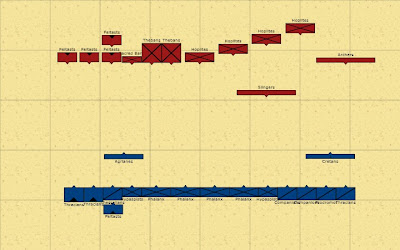 A Roman expeditionary force composed of a standard consular army with support arrives in the Po Valley in the next instalment of the Empire Campaign. The Roman consul of the day sees a long line of Gallic skirmishers strung out across a low ridge and orders the army to deploy as standard. The Latin legions are in white to differentiate them from the rest of the army in red. Billy and I split the forces right down the middle; I take the left half, he commands the right.
A Roman expeditionary force composed of a standard consular army with support arrives in the Po Valley in the next instalment of the Empire Campaign. The Roman consul of the day sees a long line of Gallic skirmishers strung out across a low ridge and orders the army to deploy as standard. The Latin legions are in white to differentiate them from the rest of the army in red. Billy and I split the forces right down the middle; I take the left half, he commands the right.Simon deploys the Gauls (in blue) behind the ridgeline with large warbands offset towards the Roman army's right. William plays the rightmost half of the Gallic host, Mark the left.
Billy holds the Roman right in place while I attack with the left; in mirror-image fashion, the Gauls do the same. I manage to catch and destroy the Gallic cavalry facing me (they failed their control tests as non-light cavalry trying to evade), and I also wipe out their rightmost warband. Billy's Roman legion grinds against the next warband in line, but his Latins and Italians are in real trouble against the masses facing them. Even with the consul joining in to try to shore up the rightmost Latin legion, the warbands joyfully destroy everything in front of them and the consul goes down like a true hero of Rome. Their left wing forces destroy the Equites and Light Horse facing them.
The battle turns on whether Billy's Roman legion can break through before being flanked. The Romans finally beat their opponents, but the leftmost Gauls manage, slowly, to turn inwards and catch the Romans, winning the battle by fifteen figures. My forces were too far out of position to intervene in time, so the second consul withdraws the rest of the army in full order.
In campaign terms, this is actually a good result. The interface that we have evolved between Empire and Tactica II has resulted in a "flattening" of the modifiers in the boardgame, making it hard for attackers (even with a Great Captain) to make massive conquests quickly. The defeat in Cisalpine Gaul should stall Rome for another while and let us see how things develop elsewhere; otherwise, the Rise of Rome could occur very early on, and perhaps become unstoppable.
One of the problems with this kind of battle is that the lines can disintegrate, becoming rather messy after the strong infantry contingents finally break through. It took a while for the Gauls to consolidate and make the final push, but after their demolition of the Latins on the right it was pretty much certain they would do so. It just took a while, and wasn't very interesting to play out. Simon came up with an idea to to abstract this situation: allow medium or heavy infantry to head for the (artificial) table base edge and gain points by looting the camp/settlement. Games in the DBX stable make this a major feature; it is lacking from Tactica II because it's unnecessary in pick-up games under the rules. It would be easy enough to insert, say by allowing a unit to score damage against the enemy in army break points according to its size. This would penalise armies that unrealistically hug the table edge, and also provide a realistic victory objective. In the case of the game just played, the Romans are trying to push through the defending army and take the dominant settlement in the region, while the Gauls would gain by breaking into the Roman army's camp and lines of communication. This could save us some valuable time on club nights.
I do like this modification, and I'll suggest that we play it in the next fight in two week's time: the Macedonians make another determined push in the Pontus region against the last of the Great King's hoplite contingent.


























.png)

.jpg)





























.jpg)




.jpg)
































































